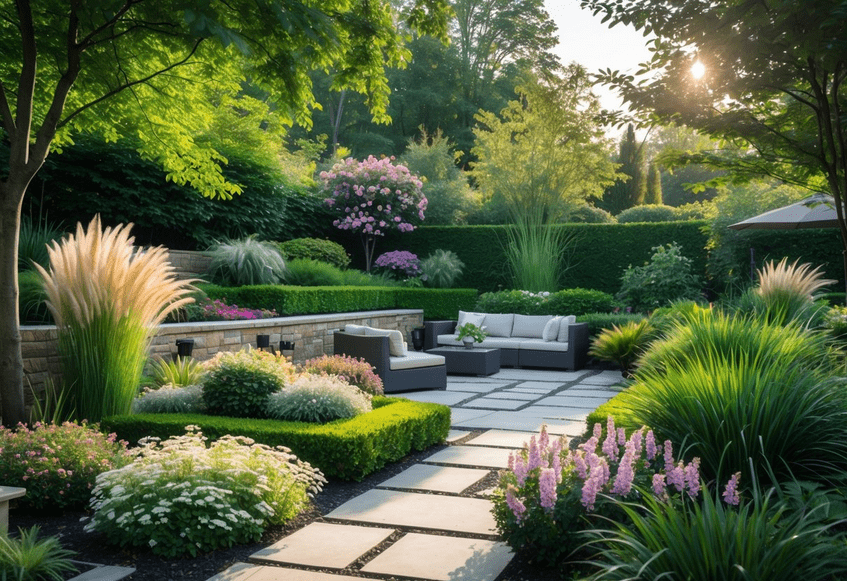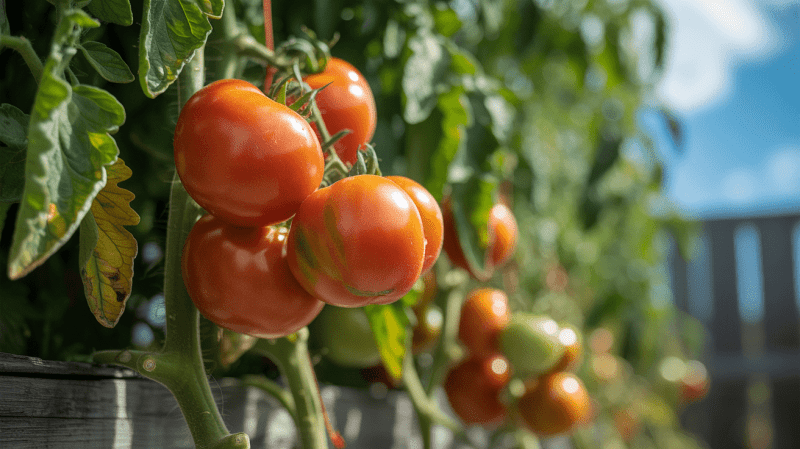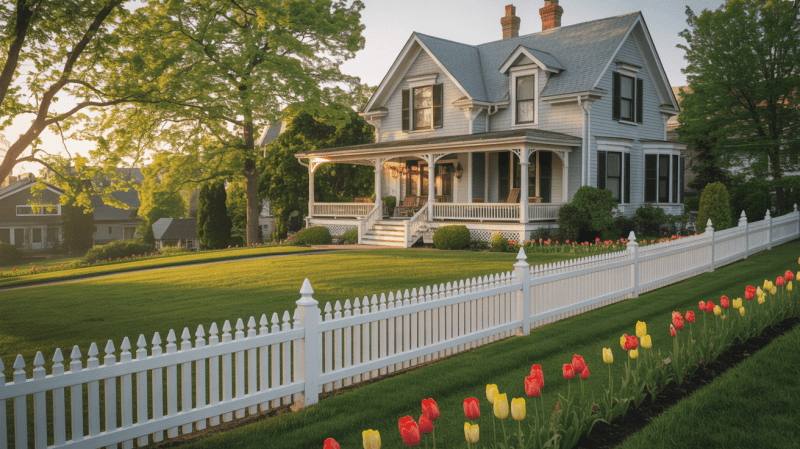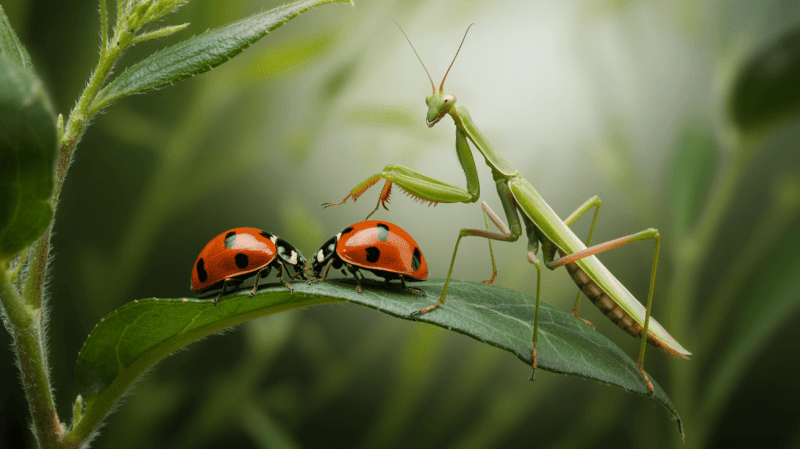Transform Your Outdoor Space:
Your backyard has the potential to become your favorite vacation spot without ever leaving home. With the right landscaping choices, you can transform any outdoor space into a personal retreat that rivals the best luxury resorts.

Smart landscaping updates can transform your ordinary backyard into a relaxing retreat that offers entertainment, comfort, and peace right outside your door. Whether you want a tropical paradise with lush plants or a cozy space with a fire pit and seating, the right design elements make all the difference.
We'll show you ten proven landscaping ideas that work for different budgets and yard sizes. These practical solutions help you create the perfect balance of beauty and function so you can enjoy your outdoor space year-round.
Key Takeaways
- Transform your backyard into a personal retreat using strategic landscaping and design elements.
- Combine hardscape features, such as patios and fire pits, with comfortable seating areas for maximum enjoyment.
- Add plants, lighting, and decorative touches to create a resort-like atmosphere in your own yard.
Designing Your Backyard Getaway
Smart planning and thoughtful design choices turn ordinary yards into relaxing outdoor spaces. We focus on creating functional zones, selecting themes that match your style, and adding elements that promote comfort and peace.
Planning the Layout and Zones
We start by mapping out different areas for specific activities. This creates flow and makes the space more useful.
Main zones to consider:
- Dining area - Space for outdoor meals and gatherings
- Relaxation zone - Quiet spot for reading or napping
- Activity area - Open space for games or play
- Garden space - Plants, flowers, or vegetables
We measure the yard first. Then we sketch where each zone fits best. Sunny spots work well for dining areas. Shaded corners make perfect relaxation zones.
Key layout tips:
- Keep pathways at least 3 feet wide
- Place seating away from busy areas
- Group similar activities together
- Leave open space for movement
We also think about views from inside the house. The best zones should be visible from windows or doors. This connects indoor and outdoor living spaces.
Choosing a Landscaping Theme
A clear theme guides all design choices. We pick styles that match the house and personal taste.
Popular backyard themes:
- Tropical - Palm plants, bright colors, water features
- Modern - Clean lines, simple plants, metal accents
- Cottage - Mixed flowers, curved paths, cozy seating
- Desert - Succulents, rocks, drought-resistant plants
We consider the local climate when choosing themes. Tropical styles need lots of water. Desert themes work in dry areas.
Theme elements to match:
- Plant types and colors
- Furniture materials
- Pathway styles
- Lighting fixtures
- Water features
The best themes feel natural in the setting. We avoid mixing too many different styles in one space.
Essential Elements for Relaxation
Comfort features transform basic yards into backyard oasis spaces. We add elements that appeal to all the senses.
Must-have relaxation features:
- Comfortable seating - Cushioned chairs, hammocks, or benches
- Shade options - Umbrellas, pergolas, or mature trees
- Water sounds - Fountains, small ponds, or wind chimes
- Soft lighting - String lights, lanterns, or path lights
Plants play a big role in creating calm spaces. We choose varieties that look good and smell nice. Lavender, jasmine, and herbs add natural scents.
Comfort additions:
- Outdoor rugs for soft surfaces
- Side tables for drinks and books
- Weather-resistant storage
- Heating elements like fire pits
Privacy helps people relax more. We use tall plants, screens, or fences to block views from neighbors. This makes the space feel more like a personal retreat.
Incorporating Hardscape Features

Hardscape features utilize non-living materials, such as stone, concrete, and pavers, to create a structured foundation in your backyard landscaping. These permanent elements define spaces, control water flow, and add visual interest that lasts through all seasons.
Installing Pavers for Paths and Patios
Pavers transform ordinary ground into defined walking areas and outdoor living spaces. We can choose from concrete, brick, or natural stone pavers to match our home's style.
Concrete pavers offer the most budget-friendly option. They come in a variety of colors and shapes. We can find them for $2 to $ 5 per square foot.
Brick pavers create classic appeal with red tones. They cost $3 to $ 8 per square foot. These work well for traditional home styles.
Natural stone pavers offer a premium look but cost $10-$ 20 per square foot. Flagstone and slate are popular choices.
For installation, we need to excavate 6-8 inches deep. We add a gravel base, then sand for leveling. The pavers go on top with sand swept between joints.
Path widths should be at least 3 feet for comfortable walking. Main walkways are most effective at 4-5 feet wide.
Patio sizing depends on furniture needs. A dining table for four needs about 10x10 feet of space.
Adding Boulders for Natural Appeal
Boulders bring natural texture and focal points to our backyard landscaping. These large stones create instant visual weight and help anchor plantings.
We can use boulders as accent pieces near water features or at the corners of garden beds. Single large boulders work well as specimen features.
Grouping boulders in odd numbers looks most natural. We arrange them with different sizes - one large, one medium, one small.
Boulder placement requires heavy equipment for stones over 200 pounds. We need to plan access routes before placing the order.
Local quarries offer the best prices and regional stone types. Granite, limestone, and sandstone are common choices.
Drainage considerations matter when placing boulders. We avoid low-lying areas where water tends to collect. Proper grading prevents water from accumulating around the stones.
Boulders pair well with drought-tolerant plants, such as ornamental grasses and succulents. The contrast between hard stone and soft plants creates visual balance.
Defining Spaces With Retaining Walls
Retaining walls solve slope problems while creating defined planting areas and seating spaces. These structures hold back soil and prevent erosion.
Wall height determines building requirements. Walls under 3 feet in height usually require no permits. Taller walls require engineering plans.
Material choices include concrete blocks, natural stone, or timber. Concrete blocks cost $15-25 per square foot installed. Natural stone costs $25-50 per square foot.
We need proper drainage behind all retaining walls. Gravel backfill and drain pipes prevent water buildup and wall failure.
Stepped walls are more effective than single tall walls on steep slopes. We build multiple shorter walls instead of one high wall.
Built-in features enhance the functionality of retaining walls. We can include bench seating, planter pockets, or lighting fixtures.
Wall caps protect the structure and provide a finished look. Concrete caps are less expensive, while natural stone caps perfectly match stone walls.
Creating Cozy Gathering Spaces

A well-designed fire pit area serves as the heart of outdoor entertainment, while comfortable seating arrangements and thoughtfully planned lounges transform any backyard into a welcoming retreat. These elements work together to create the perfect outdoor space for family gatherings and quiet evenings.
Building a Fire Pit Area
The fire pit becomes the focal point of our backyard oasis. We can choose from three main types: built-in stone, portable metal, or DIY options.
Built-in fire pits offer the most permanent solution. We dig a circular area about 3-4 feet wide and line it with fire bricks or stones. This creates a safe burning area that lasts for years.
Portable fire pits work well for smaller spaces. We can move them around our outdoor space as needed. Metal bowls or decorative designs give us flexibility without permanent changes.
Safety comes first with any fire pit. We need to place it at least 10 feet from buildings, trees, or fences. A fire extinguisher or water source should stay nearby.
The seating area around the fire pit needs planning too. We arrange chairs or benches in a circle about 6-8 feet from the flames. This distance keeps everyone warm without getting too hot.
Integrating Outdoor Seating
Outdoor seating creates the foundation for gatherings. We mix different seating types to fit various group sizes and activities.
Built-in benches work well along deck edges or garden walls. They save space and provide permanent seating that matches our design. We can add cushions for extra comfort.
Moveable furniture gives us more options. Weather-resistant chairs, sofas, and ottomans allow us to change layouts for various events. We choose materials like teak, aluminum, or all-weather wicker.
| Seating Type | Best For | Maintenance |
|---|---|---|
| Built-in benches | Small spaces | Low |
| Outdoor sofas | Large groups | Medium |
| Individual chairs | Flexible layouts | Low |
We create conversation areas by placing seating in the form of U-shapes or circles. This helps people talk easily. Side tables between seats hold drinks and snacks.
Designing a Lounge or Deck
A dedicated lounge area expands our outdoor space into a true retreat. We can build a deck or designate a patio area specifically for relaxation.
Decks work well for uneven ground. We use composite or treated lumber for durability. The deck should be large enough to accommodate furniture and provide sufficient walking space. A 12x16-foot area fits most seating arrangements.
Shade elements make lounges more comfortable. We add pergolas, umbrellas, or shade sails to protect from the sun. These features also visually define the space.
Privacy screens help create a sense of intimacy. We use lattice panels, outdoor curtains, or planted barriers. Tall grasses or shrubs work as natural screens.
Lighting extends lounge time into evening hours. String lights, solar lanterns, or built-in fixtures can create an atmospheric ambiance. We install lights at various heights to achieve layered illumination.
Storage solutions keep the lounge tidy. Weather-proof boxes or benches with storage hide cushions, games, and supplies. This keeps our outdoor space organized and ready for guests.
Introducing Lush Plantings

Creating dense, green spaces requires the right combination of flowering plants, structural shrubs, and proper soil preparation. These three elements work together to build layers of color, texture, and healthy growing conditions.
Selecting Flowers for Color and Fragrance
We choose flowers based on bloom time, color, and scent to create year-round interest. Spring bulbs, such as tulips and daffodils, provide early color. Summer perennials such as lavender, roses, and peonies offer fragrance and extended blooms.
Fall flowers, such as chrysanthemums and asters, keep beds colorful into autumn. We plant flowers in groups of 3 to 5 for maximum impact.
Fragrant options include:
- Jasmine for evening scent
- Sweet alyssum for borders
- Gardenias for intense fragrance
- Honeysuckle for climbing areas
We select flowers that bloom at different times. This creates continuous color from spring through fall. Native flowers require less water and attract local wildlife.
Annuals like marigolds and petunias provide steady color all season. Perennials return each year with less replanting work.
Planting Shrubs for Privacy and Structure
Shrubs create the backbone of our landscape design. Evergreen shrubs, such as boxwood and holly, provide year-round structure and privacy screening.
We plant taller shrubs along property lines to create natural fences. Medium-height shrubs are well-suited for use around patios and seating areas. Low shrubs define walkways and garden borders.
Popular privacy shrubs include:
- Arborvitae for tall screens
- Privet for dense hedges
- Rhododendrons for spring flowers
- Viburnum for seasonal interest
We space shrubs based on their mature size. This prevents overcrowding as they grow. Fast-growing varieties like forsythia fill spaces quickly.
Flowering shrubs like hydrangeas and azaleas add seasonal color. We choose varieties that match our climate zone for the best survival rates.
Using Mulch for Healthy Beds
Mulch protects plant roots and reduces the need for maintenance work. We apply 2-3 inches of mulch around all plantings to retain moisture and block weeds.
Organic mulch options break down over time and improve soil:
- Shredded bark for long-lasting coverage
- Compost for nutrient-rich benefits
- Pine needles for acid-loving plants
- Wood chips for pathways
We keep mulch 2 inches away from plant stems to prevent rot. Fresh mulch goes down each spring before weeds emerge.
Stone mulch works well in dry climates and around drainage areas. We choose larger stones so leaves blow across instead of getting trapped.
Mulch reduces watering needs by up to 50%. It also moderates soil temperature during hot and cold periods.
Enhancing Your Getaway With Decorative Features

Decorative features transform basic landscaping into a true backyard oasis that feels like a personal retreat. Strategic additions, such as stylish planters, relaxing hammocks, and soothing water features, create focal points while adding functional beauty to outdoor spaces.
Incorporating Stylish Planters
We can instantly upgrade any backyard by choosing planters that match our design style. Large ceramic pots work well for modern spaces, while wooden barrels suit rustic themes.
Material Options:
- Terra cotta for Mediterranean looks
- Metal containers for industrial style
- Stone planters for natural elegance
Grouping planters of different heights creates visual interest. We should place tall planters in corners and shorter ones along pathways.
The right plants make planters shine. Colorful flowers like petunias add bright pops of color. Green plants like hostas provide calm, leafy backdrops.
We can move lightweight planters to change our space seasonally. Heavy stone planters work better as permanent features that anchor seating areas.
Adding a Hammock for Relaxation
A hammock creates the perfect spot for afternoon naps and evening reading. We need two strong anchor points, approximately 12-15 feet apart, for proper setup.
Tree-mounted hammocks work best when trees are healthy and thick enough to support weight. We should wrap straps around trees to protect the bark from damage.
Hammock Placement Tips:
- Choose shaded spots for comfort
- Avoid high-traffic walkways
- Position near gardens for pleasant views
- Keep away from sprinkler zones
Freestanding hammock frames offer flexibility when trees aren't available. These metal or wooden structures let us place hammocks anywhere in our yard.
Weather-resistant materials like polyester or rope last longer outdoors. We can add outdoor pillows and blankets for extra comfort during cooler evenings.
Installing Water Features
Water features bring peaceful sounds that mask traffic noise and create calm atmospheres. Small fountains work well in compact spaces, while larger ponds are better suited to bigger yards.
Self-contained fountains require only an electrical outlet to operate. These units recycle water through pumps, making them low-maintenance options for busy homeowners.
Popular Water Feature Types:
- Tabletop fountains for patios
- Wall-mounted spouts for small areas
- Garden ponds with plants and fish
- Simple birdbaths for wildlife
We should place water features where we can see and hear them from seating areas. Solar-powered options reduce electrical costs and work well in sunny spots.
Adding underwater lights makes water features beautiful at night. LED lights use less energy and last longer than traditional bulbs.
Finishing Touches and Maintenance

The right lighting creates atmosphere while keeping your backyard safe after dark, and regular seasonal care keeps your outdoor space looking its best year-round.
Lighting for Ambiance and Safety
We recommend layering different types of lighting to create depth in your backyard landscaping. Path lights guide guests safely along walkways while adding a warm glow to garden borders.
String lights work well over patios and dining areas. They create a cozy feeling for evening gatherings. Solar-powered options save energy and can be installed easily without wiring.
Spotlight placement matters for safety:
- Light up stairs and level changes
- Illuminate dark corners near seating
- Highlight walkway intersections
- Focus on entry and exit points
Deck lights built into steps prevent falls. We recommend LED bulbs because they last longer and use less energy than traditional bulbs.
Timer switches let us control when lights turn on and off. Motion sensors near gates and doorways add security without wasting energy.
Seasonal Upkeep and Care
Spring cleanup gets our outdoor space ready for the growing season. We remove dead branches, clear debris from water features, and check irrigation systems for winter damage.
Essential spring tasks include:
- Pruning damaged plants
- Mulching garden beds
- Testing outdoor lighting
- Cleaning furniture and cushions
Summer maintenance focuses on watering and pest control. We check plants weekly for signs of stress or disease. Automatic sprinkler systems help maintain consistent moisture.
Fall preparation protects our backyard landscaping from cold weather. We drain water features to prevent freezing and store cushions indoors.
Winter tasks are lighter but important. We brush snow off evergreen branches and check that outdoor lights work properly during shorter days.
Frequently Asked Questions

Creating a backyard getaway involves smart planning, budget-friendly choices, and strategic design decisions. Here are answers to common questions about transforming your outdoor space into a relaxing retreat while maximizing your investment.
How can I create an inviting backyard oasis without incurring a significant expense?
We recommend starting with simple DIY projects that make a big impact. String lights, which cost less than $30, instantly create a warm atmosphere in the evening.
Adding outdoor cushions and colorful pillows to existing furniture transforms basic seating. We recommend shopping for patio furniture and decor during end-of-season sales.
Plant native species in your area. These plants cost less and require minimal water and care once established.
Create defined spaces using gravel or mulch pathways instead of expensive hardscaping. We find that these materials cost a fraction of the cost of stone or concrete, yet still look polished.
Repurpose indoor items for outdoor use. Old furniture can be transformed into garden planters with weatherproof paint and the addition of proper drainage holes.
What are the best low-maintenance landscaping options for a backyard?
Native plants require the least care since they naturally thrive in your local climate. We recommend researching which species grow well in your region.
Evergreen shrubs, such as boxwood, provide year-round structure without the need for seasonal replanting. These plants need pruning only once or twice per year.
Ground cover plants reduce the need for mulching and weeding. Options like creeping thyme or moss create attractive carpets that spread naturally.
We suggest installing drip irrigation systems for automatic watering. These systems use less water than sprinklers and reduce daily maintenance tasks.
Perennial flowers return each year without replanting. Select varieties that bloom at different times to extend the color display throughout the growing season.
How can a large backyard be landscaped on a modest budget?
Start by creating one focal area rather than trying to landscape the entire space at once. We recommend choosing the area closest to your house first.
Use inexpensive materials like mulch, gravel, or decomposed granite to define different zones. These materials cost much less than grass or paved surfaces.
Plant fast-growing trees and shrubs that will quickly fill the space. Willow trees and forsythia bushes grow rapidly, creating privacy screens.
We suggest leaving some areas as natural meadow or wildflower spaces. These require minimal investment but add texture and attract wildlife.
Create pathways using stepping stones or wood chips instead of expensive paving materials. These options cost significantly less but still provide structure.
What are some simple yet beautiful ideas to landscape a backyard?
Layered plantings with different heights create visual interest without complex design skills. We recommend placing taller plants in the back and shorter ones in the front.
Adding a single water feature, like a small fountain, creates a peaceful focal point. Self-contained fountains require no plumbing and plug into standard outlets.
Curved pathways feel more natural and inviting than straight lines. We suggest using a garden hose to lay out curves before installing permanent materials.
Fragrant plants near seating areas engage multiple senses. Lavender, rosemary, and jasmine add pleasant scents without extra maintenance.
Outdoor lighting extends the usability of your space into evening hours. Solar path lights require no wiring and charge automatically during the day.
Which backyard improvements offer the greatest return on investment?
Professional landscaping typically returns 100-200% of the investment when selling your home. We find that mature trees and well-designed plant beds add the most value.
Outdoor kitchens and fire pits create additional living space that buyers value highly. These features extend the usable months of outdoor areas.
Low-maintenance landscapes appeal to busy homeowners. We recommend investing in automatic irrigation and native plantings that reduce ongoing care needs.
Privacy screening through strategic plantings increases property desirability. Mature hedges or tree lines create a more secluded feel in outdoor spaces.
High-quality hardscaping, such as stone patios or retaining walls, can last for decades and significantly improve property value. These features require higher upfront costs but offer long-term returns.
How do you transform a small backyard into a cozy and functional outdoor space?
Vertical gardening maximizes planting space without using ground area. We suggest wall-mounted planters or trellises with climbing plants.
Multi-functional furniture serves double duty in compact spaces. Storage benches provide seating while hiding garden tools and cushions.
Light colors and mirrors create the illusion of more space. We recommend pale-colored furniture and strategically placed outdoor mirrors to reflect light.
Define separate zones for different activities using outdoor rugs or container gardens. This creates the feeling of multiple rooms within a small area.
Select compact plants that make a significant impact. Dwarf varieties of popular shrubs offer the same visual appeal in smaller spaces.
DISCLAIMER
This document is provided for general information purposes only and should not be relied upon as providing legal advice, technical, or specific operational guidance to the reader, whether as to the practices described in the document or the applicable legal requirements and regulations. Lawnfly.com expressly disclaims any responsibility for liability arising from or related to the use or misuse of any information in this document.



